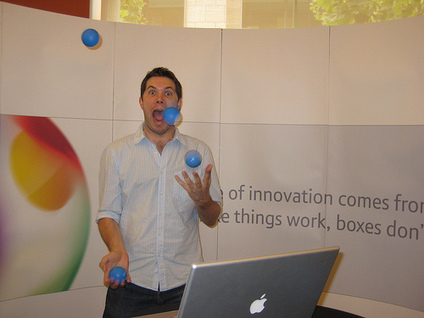Why you can’t actually multitask and how to get more done
Quick, check out how many tabs you have open on your internet browser or how many apps you have open on your phone. How many do you need to complete the task you’re doing right now (reading this article)?
While the rise in anti-texting-while-driving laws is indicative of a cultural shift away from multitasking, it’s a slow movement. We all multitask every single day. A panel of experts discussed multitasking during SXSW in March (click the link to listen), and all three thought leaders agreed: by and large, multitasking is not effective.
About Multitasking
“What’s a task?” asks Professor David E. Meyer, Ph. D., a faculty member of the Cognition and Cognitive Neuroscience Program in the Department of Psychology at the University of Michigan. “A task is a procedure involving a sequence of mental and physical processes for achieving a desired goal.” He clarifies that performing multiple tasks can happen simultaneously and in rapid succession. How effective you are depends on a variety of factors, including the tasks’ compatibility, the tasks’ cognitive load, and your history practicing them.
Each task involves a neurochannel (like language or visual-manual), but each channel has limited capacity. Conflicting tasks compete for a channel whereas compatible tasks use different channels. You can fold laundry and talk on the phone because they operate on different channels.
Additionally, while you are working on a task, even a single task, you can have both external and internal interference. How your brain processes the interference depends on your goals—if you ignore the distraction, it becomes irrelevant, but if you choose to engage in it, it becomes a distraction.
Dr. Adam Gazzaley, the founding director of the Neuroscience Imaging Center at the University of California, San Francisco, shared some unpublished research on multitasking, where study participants all played a game. Every person surveyed showed a drop in performance—in a linear progression by age—that could be mitigated by practicing the game.
How To NOT Multitask (or, how to become more productive)
Say this word ten times: silk. Silk, silk, silk, silk, silk, silk, silk, silk, silk.
What does a cow drink?
…
Actually, water.
Multitasking is a habit and we’ve been taught to multitask. But if it’s with incompatible tasks, it’s not effective. Peter Bregman, author of 18 Minutes: Find Your Focus, Master Distraction, and Get the Right Things Done, lays out five steps to break the multiasking habit and find your focus, increasing productivity.
1. Plan Your Environment
Literally take away the thing that enables you to multitask. Put your phone away, disable the internet, whatever you need to do in order to create an environmental change.
2. Do Less
Create a six-box to do list for the year. The first five boxes are areas of focus you want to move forward in a year. The sixth box houses everything else. Every single day, take a look at the list of things you most want to get done and make sure you’re doing them.
Also create an Ignore List: things you know you would use to distract yourself if you were to allow yourself. Ignore them.
3. Gamify Your Work
That is, shorten your work to make it more interesting, move faster, and focus only on the most important data. Shorten the time, shorten the resources, and you’ll find that you focus more. For example, think about driving 95 miles an hour—you won’t want to text.
4. Effectively Multitask Without Drag
You can do multipurpose tasks and compatible tasks without dragging down your performance and productivity. Multipurpose tasks like biking—you get where you need to go and get exercise—are a great use of time. Compatible tasks like folding laundry while listening to the news reduce the negative impact of multitasking.
5. Become Conscious of Your Behavior
First, set a watch to beep every hour. When it beeps, stop working for one minute. Take a deep breath, ask yourself ‘am I doing what I most need to be doing right now?’. The other 59 minutes of work will be more focused.
Second, take five minutes at the end of the day to stop and analyze how your day went, what worked and didn’t, and consider what you plan to do tomorrow and how you want to do it differently.
The bottom line? No matter how good you think you are at multitasking, your brain just isn’t wired to work that way. When you can focus on one task at a time, you’ll perform it better and often quicker. Give one—or all—of these strategies a shot to reap the rewards of taking multitasking to task.
Image: Some rights reserved by Phillie Casablanca

